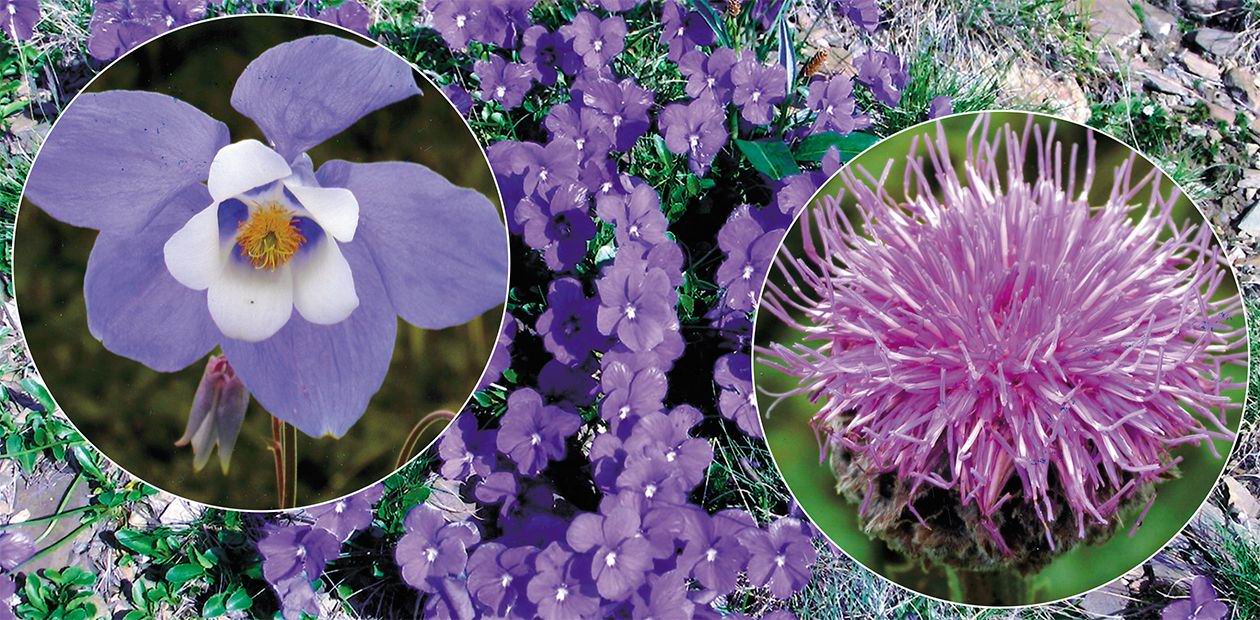A Lost Archipelago: The Altai Krai through the Eyes of a Botanist
Right in the middle of Eurasia, where the West-Siberian Plain borders on the grand Central Asian mountains, there is the Altai Krai. You hardly find another region in the Asian part of Russia whose nature has so long and so thoroughly been transformed by people. Pieces of natural ecosystems untouched by humans seem to form islands in the sea of crop lands. They make up a virtual archipelago unseen by a casual observer but nonetheless as fascinating and varied as those distant tropical isles.
The Altai krai is one of the most populated and domesticated of Siberian regions located in the vicinity of the Novosibirsk scientific centre largely remains a terra incognita for scientists. In the meantime the data about ecosystems of the south-eastern part of West Siberia are crucial for understanding patterns in constitution and behavior of vegetation in the whole of Siberia as well as biospheric trends in global climate changes. All of the above provoked scientists from the Central Siberian Botanical Garden of the Siberian Branch of the Russian Academy of Sciences to start systematic botanical and geographical research in the region.
Right in the middle of Eurasia, where the West-Siberian Plain borders on the grand Central Asian mountains, there is the Altai Krai. You hardly find another region in the Asian part of Russia whose nature has so long and so thoroughly been transformed by people. It is a paradox that one of the most populated and domesticated of Siberian regions located in the vicinity of the Novosibirsk scientific centre largely remains a terra incognita for scientists
Nowadays, it is rather difficult and at times impossible to imagine what the landscapes of the Altai region looked like prior to its transformation by man. The monotonous scenery of crop fields interspersed with bleak, artificially grown tree belts opens up to a traveler’s eye. Closer to the Altai and Salair mountains the scenery livens up with hills and mountains sometimes covered with fir or broad-leaved trees. But most of these woodlands have been deforested times and again and suffered numerous fires. The modern structure and composition of the left over forests attests in a greater degree to the history of husbandry than to the natural historic circumstances of their formation. Only small isolated areas of woodlands, which for various reasons have escaped anthropogenic influence, still keep invaluable information about natural forest ecosystems of this land.
Probably this lack of aesthetic appeal and apparent simplicity of Altai plains largely explains why in former times nature explorers hurried to cross the monotonous landscapes in order to reach the mysterious mountains of Altai and Kazakhstan. The vast majority of modern natural scientists hardly differ from them.
In the meantime the data about ecosystems of the south-eastern part of West Siberia are crucial for understanding patterns in constitution and behavior of vegetation in the whole of Siberia as well as biospheric trends in global climate changes. It is here that we come across at least two planetary phenomena which are well observed in satellite pictures and small-scale geographical maps of the territory. Firstly, a larger part of the contact area between the West-Siberian plain and Altai-Sayan mountains is located here. Secondly, here we have the largest barrier in the Asian part of Russia in the way of western transfer of air masses. These facts demand a closer look at this region which continues to be a “terra incognita.”
As of today the vegetation of the Altai Krai has retained its basic biological diversity despite a powerful anthropogenic pressure. Thus, the local flora of superior vascular plants includes some two thousand species (about 40 % of all Siberian flora) not counting 300 stranger species. A variety of landscapes in these parts brought about diversity of its vegetation: one can see here the whole range of Siberian ecosystems from desertified steppes to subalpine meadows and highland tundras. All of the above provoked scientists from the Central Siberian Botanical Garden of the Siberian Branch of the Russian Academy of Sciences (CSBG SB RAS) to start systematic botanical and geographical research in the region.
Steppe and more steppes…
Despite the fact that the western part of the Altai Krai is proudly named the Altai Steppes, the latter hardly dominate here. Usually they are located close to villages, with all consequences that come with it. It is rather difficult and at times impossible to find a real steppe on the plain, the one with little influence from the man and with an area of over a hectare. And yet, the search for such ecosystems is of ultimate importance – preserved virgin steppes serve as yardsticks which make possible to estimate the scope of anthropogenic influence in the past and to install a monitoring system in the present.
Research rarely finds anything among croplands but remains of full-scale bioceonses which do not retain all basic features of original ecosystems. In this respect, the work done by botanists at flatlands is similar to that of criminologists trying to piece together a full-bodied picture of a recent past. Pieces of natural ecosystems untouched by humans seem to form islands in the sea of crop lands. They make up a virtual archipelago unseen by a casual observer but nonetheless as fascinating and varied as those distant tropical isles.
In a limited area of the Altai Krai one can see communities ranging from dry barren grasslands of Kazakhstan type to rich and colorful meadow steppes, flat and mountainous steppes as well as their numerous versions in sandy, salty and stony locations. Although these surviving spots of natural biocenoses may be similar in vegetation type and floral composition, similarly to ocean islands, they contain specific features which may not be discerned in satellite photos or thematic maps. Out on a field trip a scientist feels like a pioneer and looks out for surprises, which may be plants that are new or rare for this territory. Quite often such expectations come true.
Contributing greatly to the success of geosystemic research is easy access to satellite data, development of the technology of Earth sounding, and the Internet. Satellite shots of the Altai Krai show all preserved areas of natural complexes scattered around boundless fieldsBy way of example, all participants of the CSBG SB RAS botanic expedition organized in 1995 were amazed when they discovered picturesque landscapes of a desert look at the border of the Altai Krai and Kazakhstan, on the bank of an ordinary lake of Bolshoi Tassor (Uglovski district). Examination of the flora of this small place gave more reason for astonishment – a large group of Iranian-Turan plant species was discovered here, with the lake’s basin being the north-eastern border of their realm.
Considering a moderate size of this territory, it may well be the place of highest concentration of rare plants species within Altai or even the whole Siberia. Considering the uniqueness, exciting history and vulnerability of this biocenocis, scientists put forward a proposal to establish a reserved area around Lake Bolshoi Tassor. A multi-functional nature reserve was established here in 1999.
Mat-grass under pine-trees
The most outstanding and amazing feature of this land must be the ribbon-like pine forests. When one looks at a map or a satellite shot of the area, the eye is involuntarily drawn to a series of parallel stripes crossing the plains. Sometime in the past these stripes were continuous ribbons of grassy pine forests, which served as a source of wood and wood coal for people. Centuries of husbandry in these forests could not but leave their traces. Instead of ribbons, these now look like chains of islets of comparatively intact forests, where one can still admire centennial pine-trees towering over steppe mat-grass.
While moving along such a ribbon from north-east to south-west, from “island” to “island”, one can notice regular change of vegetation mantle from typically sylvan grass and winter-green bushes to steppe type drought-resistant species. Pine forests in the north, with lots of mountain cranberry and running moss cover, remind of taiga forests, whereas southern pine woods are similar to those of North Kazakhstan.
Ancient dune-like relief surviving under the cover of these forests makes up a colorful pattern of habitats occupied by ecologically contrasting plant species. Close together there may be steppe astralagus, taiga fern and uliginous sedge. Here barren sandy soil borders on wet and salty soil. At times the tension and pace of natural processes in this native laboratory is perceived almost physically.
Many people know the unique linden island in Gornaya Shoria, but few have heard that the Altai Krai has a linden island of its own. About 60 ha of the Oudin wood farm, the Alambai forestry, in the Salair mountains is occupied by unique woods of Siberian linden – the only Siberian broadleaved tree. Linden trees here reach 20—22 meters of height and 34—36 centimeters in diameter. They blossom and bring fruit. Linden sprout appear abundantly under the cover of the forest but apparently perish on a large scale after hibernation.
A peculiar feature of Siberian linden forests is the presence of some plants and mushrooms unusual for Siberia but common for broadleaved woods of Europe and the Far East. According to our present notion, these species in Siberia are regarded as relics of preceding geological periods. The presence of such nemoral relics (from Latin nemorum – oak) has long thrilled Siberian botanists. Forests with a lot of relict plants and mushrooms are considered to be unique remains of the fir and broadleaved woods of Pliocene which survived the cold era in special havens.
It seems that the very presence of typical broadleaved trees should strongly testify to the previous existence of the corresponding forest environment in the past. However, if one looks at biological traits of linden, it turns out that it is the only broadleaved tree in Russia capable of forming specialized subterranean roots (ksilorizomas). This makes it possible for linden to reproduce effectively by vegetation and survive indefinitely long in forest communities in the form of creeping bushes.
This ability of vegetative reproduction is also fully inherent in Siberian linden. In the vicinity of the Altai “Linden Island,” one repeatedly spots linden under the canopy of aspen-fir forest, where it is represented by low bushes of vegetative origin, up to half meter high, sometimes connected by long subterranean ksilorizomas. According to native inhabitants, the grove itself sprang in the place of a clean felling carried out before the World War II, which means it is of secondary nature. One may suppose that ability to produce a life-form of low-growing shrub and especially ability to reproduce vegetatively played a major part in its survival in a hostile environment. Still the question of the origin and genetic connection of these wonderful forests remains open.
Altai Mediterranean
Of all forest vegetation in this krai the word “archipelago” is most appropriate for separated birch forest stands. Due to local relief and climate peculiarities, birch forests located on the Kulunda plains and Priob (Cis-Ob) plato have always (even in prehistoric times) been small patches scattered over steppes.
Here we can see effects of island-like biogeography in full! Every separate forest stand is unique and inimitable in its structure and content. Depending on the relief, separated birch forest stands are located either in the center of shallow saucer-like dishes or at northern slopes of deeply cut bridles. In both cases they represent typical gradient ecosystems, when inside a relatively uniform forest mass there is a distinct gradient along a slope or from the center of a bridle to its fringe.
Thanks to this, separated birch forest stands maintain a high degree of species diversity – the number of superior vascular plants reaches 80—100 over 100 m2. The fringe of a forest stand serves as a buffer for its internal part largely leveling out external ecological conditions. This raises a probability of discovering unusual plants in the central parts of stands, such plants which might have witnessed different from modern conditions of landscape formation.
A wonderful discovery was made recently on the islands and banks of Kulunda Lake – Karagana bushes – natural bush communities dominated by Caragana arborescent located on leeward slopes of low oblong elevations produced by sandy soils.
Generally speaking, the bush type vegetation of West Siberia in forest, forest-steppe and steppe zones remains least studied. It has turned out that in Karagana bushes of the Central Kulunda Lowland there are no traces of forest flora. In its floristic content these communities are close to the vegetation of real and meadow steppes, but in their community structure and ecological content Karagana bushes are distinctly different from steppe communities.
Altai communities dominated by Caragana may be regarded as counterparts of shibliak – a peculiar vegetation type which originated in ancient Mediterranean and is represented by drought-resistant and thermophilic shrubs and low-growing trees. Similar to how shibliaks act as an ecological link between oak groves of Southern Europe and evergreen shrubbery of the drought-afflicted Mediterranean, Karagana brush in the south of West Siberia is a formerly unknown link between drier grassy pine and birch forests and shrubby versions of meadow-like and real steppes.
And of course best-known and most attractive for tourists are mountainous and high-altitude landscapes of southern Altai, which represent the north-west “face” of the Altai-Sayan mountain region. Here one observes a classical altitudinal vegetation change. As the altitude increases, the steppe zone is superseded by forest-steppe, forest, sub alpine and lastly by mountainous tundra.
In the last two zones one comes across various representatives of arctic-alpine species which witnessed Ice Ages, when the vegetation of plain tundra contacted with the vegetation of mountain tundra as it “went down” to lower land because of colder climate.
It is worthy to note that according to the theory of the outstanding Russian botanist A. I. Tolmachyov our own Siberian dark fir taiga had formed in the mountains and later descended onto a plain. In this respect the vegetation of the Altai Krai provides us with invaluable material to restore a creation history of the whole living world of Siberia.
Immigrants at gunpoint
In the last century the flora of the Altai Krai has been enriched by many new species. One can say that the vegetation world is continuously becoming richer through various economic activities. But how good is this richness? Many of the emergent species act aggressively: they integrate into natural communities changing their structure and content.
A good example is American maple, which actively reproduces under the canopy of natural pine woods and thus creates conditions incompatible with normal reproduction of pine. With an astonishing speed many immigrant species conquer areas where people exterminate natural vegetation. In the last twenty years we have witnessed active movement to the east of sumpfweed (Iva xanthiifolia Nutt.). It is not only a new weed rural dwellers have to fight in their gardens but also a highly allergenic plant.
The efficiency of further battle against aggressive immigrants depends on how long they have persisted in the landscapes. It is important to control the emergence of new species and assess risks of introducing every new species.
With every year, introduction of a monitoring system is becoming more urgent. The vegetation community is a living and dynamic subsystem of the biosphere. Vegetation is very sensitive to changes of natural conditions. This is clearly displayed in how meadows and steppes supersede forests, lakes dry up and the cleared space grows up with halophytic plants.
Besides these obvious indicators, one can study less apparent changes such as transformations in age structures of key plant populations. This allows spotting ecological shifts at an early stage. In this respect vegetation cover can supply us with a complex of indicators, desertification processes and global climate changes.
Is it possible to preserve for future generations the unique nature of the Altai Krai and inimitable beauty of its natural landscapes? To answer this question, it is necessary to conduct an interdisciplinary examination of Altai Krai ecosystems, an inseparable part of which would be botanical research.
This research will have to assess how much of the biological diversity has been irrevocably lost and what must be done to protect the things we still have. It is necessary to zone the territory and mark out locations with different protection regimes (nature reserves, wildlife reserves, natural sanctuaries, etc); zones of controlled natural resource mining and traditional farming; areas of animals and plants’ migration paths; water collection areas including these of the upper reaches of rivers; water protection and erosion preventive lands; actively used territories including settlements with adjacent recreation facilities and farm land.
Going back to the beginning of the article, let us remind the reader about the highly fragmented nature of the Altai Krai. Studying island systems is a separate branch of ecology devoted to the problem of stability of such entities, which depends on their size and anthropogenic load. This raises an interesting question: can one apply methods of studying biological diversity designed for islands and archipelagoes to these ground landscapes that have emerged as a result of people’s activities? The theory of insular biogeography may allow us to explain the reasons for the essential disparity in the flora and vegetation types of isolated natural ecosystems.
There is much work to be done. Despite the fact that the nature of the Altai Krai has been studied by various experts for many years, much of it is still waiting for its explorers.
References
Koroliuk A. Yu., Pristiazhniuk S. A., Platonova S. G. Desert-type communities in the south-east of West Siberia // Bot. zhurnal. 2000. V. 2. P. 97—105.
Koroliuk A. Yu. Protecting biodiversity of the steppe biome vegetation of West Siberia // Sibirskiy ecologicheskiy zhurnal. 1994. V. 1. #6. P. 589—594.
Lashchinsky N. N. Vegetation of the Salair range. Novosibirsk, 2009. 263 p.
The Green Book of Siberia: rare and endangered vegetation communities. Novosibirsk, 1996. 396 p.
The Red Book of the Altai Krai. Rare and endangered species of plants. Barnaul, 2006. 262 p.










